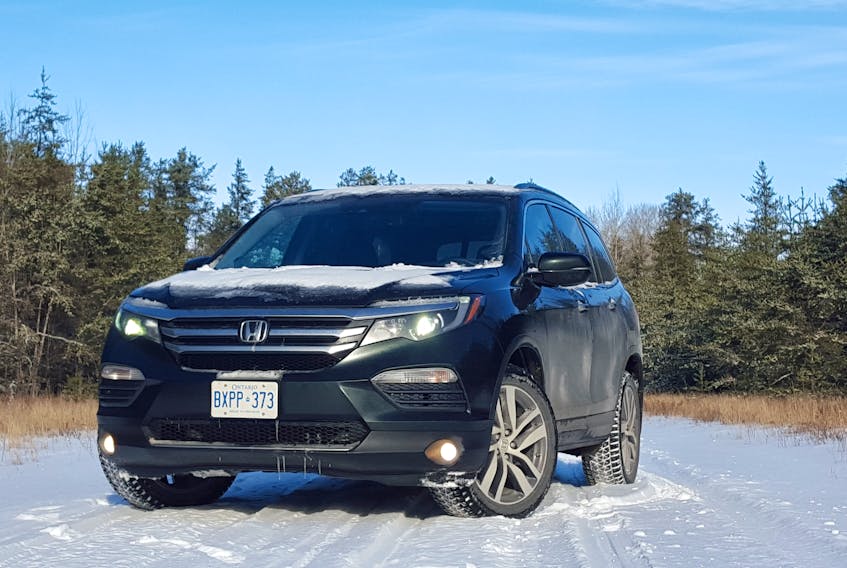The third and latest version of Honda’s biggest crossover, the Pilot, hit the road in 2015 with a new take on the modern family hauler.
Lower, longer, and more accommodating than its predecessor, the latest Pilot gave shoppers heaps of flexible on-board space, storage galore, plenty of the latest safety and connectivity features, and no shortage of high-end feature content.
Look for rear seat entertainment consoles, climate-controlled seats, a terrain-mode selector for the all-wheel-drive system, USB fast-charge ports, full Smartphone integration, a power tailgate, leather memory seats, a sunroof, premium audio systems, remote start, and more.
All models got a 3.5-litre V6 engine with 280 horsepower, and a six- or nine-speed automatic transmission. Most used models will have AWD, though front-drive-only units were available.
CHECK FOR FORWARD-FACING DAMAGE
Check your used Honda Pilot carefully for signs of damage to the front bumper and grille, as well as the windshield. A bumper damaged in an accident, or a cracked or chipped windshield, may impede the proper operation of one or more of Pilot’s outward-looking safety systems, which rely on cameras and radar mounted behind them, to do their job.
Damaged or misaligned sensors may require re-calibration at the dealer, which could cost you money.
TAILGATE RUST CHECK

Some owners say they’ve noticed premature rust on parts of the Pilot’s tailgate assembly, especially on earlier models from this generation. Apparently, a small leak in the tailgate’s sealant or welds may allow water to get inside, which can lead to the rapid formation of rust. This issue seems most likely in 2016 and 2017 models, and may qualify for warranty-related repair. Not all models are affected, but check the tailgate carefully, especially around the handle, and its lower, inner lip.
KEY FOB TESTING
Obtain both of Pilot’s key fobs, and systematically test each one, several times. Confirm that each remote or smart-key allows access to each door’s locking and unlocking functions via the external touch sensors, and that the locking, unlocking, and remote start functions work properly on each remote.
If you detect problems, change the batteries in the remotes. If problems remain, see a dealer about a software update to correct the issue, which many owners say is a quick and easy fix. Get an estimate for this work before you buy, if applicable, and call it into your pricing negotiations.
TRANSMISSION CONCERNS
Transmission shifting problems are among the most commonly reported with modern used vehicles, and the Pilot is no exception. Be on the lookout for clumsy, harsh, or unrefined shifting, especially on models with the nine-speed automatic. (Check the instrument cluster gear display readout while manually upshifting, to see whether you’re driving the six-speed or nine-speed unit).
Trouble detected might be remedied with a software update, but pricier repairs aren’t unheard of. Do not buy a used Pilot with a transmission that’s acting funny until you have it assessed professionally in a dealership setting.
PROTECT YOURSELF
Some owners question the need to properly maintain their vehicles, wondering whether a given fluid change, flush, or inspection is actually important, or just a means of driving dealer profits. Protect yourself from buying a used Pilot from one of these sellers by checking all service records against the maintenance schedule in the owner’s manual.
Note that properly-maintained vehicles tend to last longer and have higher resale values, and that skipping or stretching any factory-prescribed maintenance may put remaining warranty coverage in jeopardy. If you can’t obtain documentation to prove that the Pilot you’re buying was continually maintained, proceed assuming that any remaining factory warranty is no longer in effect.
The information presented above is gathered from online owner discussion groups and collaboration with a network of automotive repair professionals. The above information is not a comprehensive list of all possible issues with the vehicle in question and is instead intended to draw shopper attention to possible trouble spots they may wish to investigate before they buy. In most cases, problems listed above are reported with relative rarity in comparison to total sales volume. Shoppers are advised to have a dealer-performed pre-purchase inspection on the vehicle they’re considering for maximum peace of mind.
RELATED:









